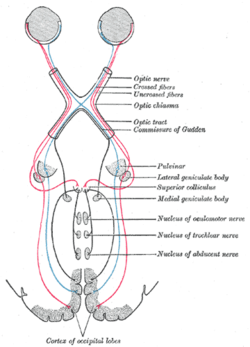Optic chiasma
The optic chiasma, or 'optic chiasm',[1] is the part of the brain where the optic nerves (CN II) partially cross. The optic chiasm is located at the bottom of the brain immediately below the hypothalamus.[2]


Pathways
changeThe images on the nasal (inner) sides of each retina cross over to the opposite side of the brain via the optic nerve at the optic chiasm. The temporal (outer) images, on the other hand, stay on the same side. This allows the images from either side of the visual field to go to the appropriate side of the brain, combining the sides together.
Beyond the optic chiasm, with crossed and uncrossed fibers, optic nerves become optic tracts.
The crossing over of optic nerve fibres at the optic chiasma allows the visual cortex to receive the same hemispheric visual field from both eyes.[3]
The optic chiasma is found in all vertebrates.[4][5]
References
change- ↑ Greek χίασμα, "crossing", from the Greek χιαζω 'to mark with an X', after the Greek letter 'Χ', chi
- ↑ Colman, Andrew M. 2006. Oxford Dictionary of Psychology. 2nd ed, Oxford University Press. p530 ISBN 0198610351
- ↑ Eye, human. Encyclopædia Britannica 2006 Ultimate Reference Suite DVD 2009.
- ↑ Bainbridge, David (2009). Beyond the Zonules of Zinn: a fantastic journey through your brain. Harvard University Press. p. 162. ISBN 978-0-674-02042-9.
- ↑ de Lussanet, Marc H.E.; Osse, Jan W.M. (2012). "An ancestral axial twist explains the contralateral forebrain and the optic chiasm in vertebrates". Animal Biology. 62 (2): 193–216. arXiv:1003.1872. doi:10.1163/157075611X617102. ISSN 1570-7555. S2CID 7399128.